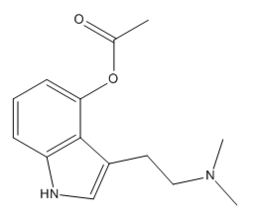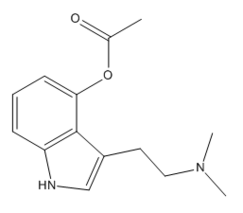4-AcO-DMT
Psilacetin (also O-Acetylpsilocin, 4-Acetoxy-DMT, or 4-AcO-DMT), a synthetically produced psychoactive tryptamine suggested by David Nichols to be a potentially useful alternative to psilocybin for pharmacological studies.
Chemistry


Psilacetin is made up of a tryptamine backbone with an acetoxy (acetyl) group attached to carbon R4 of the indole ring, and two methyl groups substituted onto the nitrogen RN1 and RN2.
Pharmacology
Psilacetin acts as a 5-HT2A, 5-HT2C and 5-HT1A partial agonist; the psychedelic effects are believed to come from psilacetin's efficacy at the 5-HT2A receptors. At high doses, there is some efficacy to noradrenaline receptors.
It is observed to shift cellular metabolic processes from those which rely on the deacetylace enzyme, an important enzyme in catabolic reactions, to other processes for generating energy. The substantiative observable physical effect is the feeling of cold at the cellular level, as if heat has not been produced as it normally is and metabolism has shifted en mass to anabolic or other processes. The perception of these gaps of heat is (relatively speaking) quantitized and feels subjectively like holes in a lattice. This sense is most noticable in cartilige rich tissue subject to cooling effects of breathing (i.e. the nose)
The physical effects of Psilacetin are most notably attributed to its metabolic route, the deacetylase enzyme in part. This enzyme is responsible for catabolic energy generation processes at a cellular level (see:mitochondria). At doses between 100 and 250 mg it becomes noticable that the body quantitizes heat as energy as part of ongoing processes which sustain life. This heat must be produced by other means, and shivering is quite common during exposure to cold temperatures.
Subjective effects
"i projected my thoughts and watched others do the same. Their projections appeared encrypted to me."
At high doses its apparent that thought is projected quite easily into space by the minds eye. These thought projections are theorized to be illuminated by the fluorescence of the tryptamines. By resonating with the frequencies accompanying the visual space is it appears in bright focus as a separate reality, a fluorescing projection. The usefulness of this is attenuating to silence. The smallest sound within the body is perceptable, even if it is not audible, and the lattice vibration induced by the sudden shift is one such such inaudible sound.
There was also a shared experiency by multiple observers of being admitted by an entity into several different simulations.
- Spontaneous tactile sensations - the body high of Psilacetin can be described as a pleasurable, warm, soft and all encompassing tingling sensation. At high doses this sensation can correspond to feedback produced from a simulation.
- Sedation - in terms of effects on the physical energy levels Psilacetin is considered relaxing, yin, and mildly sedating. These sensations may be accompanied by compulsive yawning, a runny nose and watering eyes.
It's described by many as extremely relaxing and immersingly visual (in breakthrough) compared to other commonly used psychedelics such as LSD or 2C-B which tend to be energetic and stimulating. It contains a large number of psychedelic typical and unique cognitive effects.
The most prominent of these typical effects include:
- Introspection
- Connectivity of thought
- Outrospection
- Emotion
- Feelings of fascination, importance and awe
- Conceptual thinking
- Direct communication with the subconscious
- Entity Contact
- Ego death
- Time distortion
- Deja-vu
- Unity consciousness
The most commonly reported unique cognitive effects include:
- Cognitive enhancement and suppression cycles - Can be described as constant waves of extremely stimulated and profound thinking which are spontaneously surpassed cyclic by waves of general thought suppression and mental intoxication. These two states seem to switch between each other in a consistent loop once every 20 - 60 minutes.
- breakthrough: encryption in perceptual artifacts - A common theme is the perception of (seemingly infinite) indexies. Some of the imagery seemed, subjectively, to contain artifacts of encryption. Perhaps this is merely a function of the speed of the trip at peak and not having time to put all the visual information into words. The visual part is immersing such that the soundtrack/auditory component incorporates the visual data, leaving a lot implied/assumed. The peak visuals in breakthrough seem as though they do not occur linealy in time, as in extreme time dialation (inception). Afterwards, the memories are consolidated, the brain isn't expecting to get hours of immersing sense data in minutes so most of it ends up as diseparate lacking the grain of expressability which came with continuity of abstract visual metaphors. Without (quickly) putting the important visual aspects into words one is left with very little of value except the inexpressable truth which has been recieved. Most noted at high (200+mg) doses.
The entity which admits one to the simulations did not communicate with us. Admittedly it was a pretty sketchy amusement park.
Psilacetin presents a full and complete array of possible visual enhancements which generally includes:
As for visual distortions and alterations, effects experienced are detailed below:
- Drifting (Melting, Flowing, Breathing and morphing) - in comparison to other psychedelics this effect can be described as highly detailed, slow and smooth in motion and static in their appearance.
- Tracers
- After images
- Texture repetition
- Colour shifting
- Scenery slicing
The visual geometry that is present throughout this trip can be described as more similar in appearance to that of 4-AcO-DMT, Ayahuasca and 2C-E than LSD. They can be comprehensively described as structured in their organization, organic in geometric style, intricate in complexity, large in size, fast and smooth in motion, colourful in scheme, glossy in colour, blurred in their edges and rounded in their corners. They have a very "natural" feel to them and at higher dosages are significantly more likely to result in states of Level 7B visual geometry over Level 7A.
The auditory effects of Psilacetin are common in their occurrence and exhibit a full range of effects which commonly includes:
Toxicity and Harm Potential
Danger Potential
The danger of psilacetin stems from its being metabolized in part by the deacetylase enzyme. This enzyme is used by the body in catabolic reactions at a cellular level. High doses (100-250mg) suspend this process for a time, by competeing for the enzyme. This can make one extremely sensitive to cold. It is possible to reach a staate of hypothermia quite easily at high doses and the lethality is likely attributable this acute effect.
Lethal Dosage
The LD50 of psilacetin has been extrapolated from animal results to 800mg for an average human. One may safely assume the lethal dose of psilacetin is 450-500mg. Above 300mg is excessive for most purposes.
Tolerance and Addiction Potential
Psilacetin does not exhibit the same tolerance as other tryptamines. The deacetylace enzyme is used extensively for the aforementioned cellular processes related to heat generation. These reactions are highly regulated and directly affected by this compound in such a way that a tolerance is not possible. This opinion is shared by experienced users.
Legal Issues
Possession and sale of psilacetin is unscheduled in most countries.
- UK: Could be considered illegal under the 1971 Misuse of Drugs Act as it metabolises into psilocin.
- USA: Could be considered illegal under the Federal Analog Act as an analogue of psilocin.
